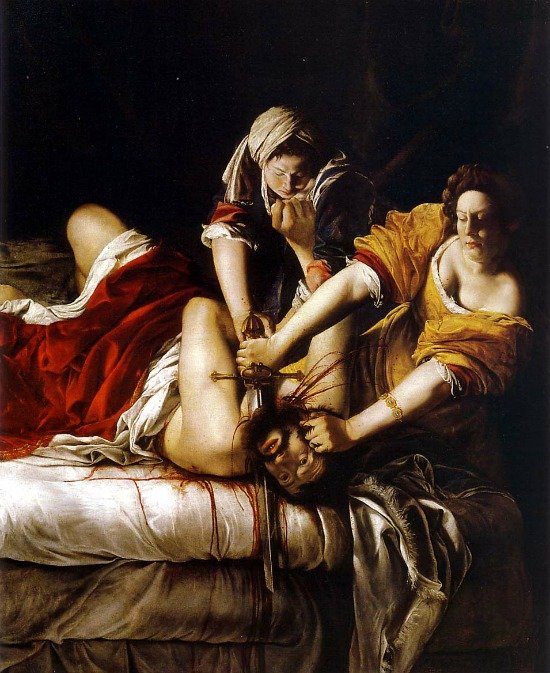Life in Rome - The Artemisia Gentileschi Exhibit
Buon Anno!Man, am I happy to see 2017. I'm really looking forward to this year, despite all the craziness in the world. I have no control over these many complicated political and social issues but I can control how I react to them.There's a lot of ugliness and hatred in this world. I'm going to focus on the beauty and love. I know that sounds very Pollyanna. However, I strongly believe that those of us who work in creative fields and/or appreciate creative endeavors need to push back. Dostoyevsky wrote, "Beauty will save the world." I agree.If you're in Rome or plan to visit before May 7th, I highly recommend the “Artemisia Gentileschi and Her Time,” exhibit at the Museum of Rome in Palazzo Braschi. It's outstanding.Much has been written about the struggles of Gentileschi (1593-1653). This exhibit doesn't downplay them but focuses on her art and how the times influenced it. There are over one hundred paintings. Most are by Gentileschi with a few from her contemporaries.Gentileschi was the daughter of the painter Orazio and was heavily influenced by Caravaggio. She was the first woman to be admitted to the prestigious Accademia del Arte di Disegno in Florence.The population in Rome was two-thirds male when Gentileschi was growing up. It was very dangerous for a woman to be even be outside. Her mother died when she was twelve and she was raped by the painter her father hired to tutor her when she was seventeen. Her father had to hire a tutor because at the time women were denied access to the art academies. During the humiliating trial, Gentileschi was tortured and her family's reputation questioned. Her accuser (who had raped his wife, his sister-in-law, and tried to steal paintings from Orazio) was sentenced to a year in jail. His verdict was annulled.Gentileschi rejected the stereotypical female roles of the Early Baroque era and painted women who were powerful, mythical.The exhibit is categorized by city. You can see the influence living in Rome, Florence, Venice, London, and Naples (where she died, perhaps from the Plague) had on Gentileschi's work. After her death, Gentileschi's work was often attributed to her father or other artists.The exhibit is well organized (I know. Shocking). There are informative introductions (in Italian and English) to each period of her work.I saw her most famous work, Judith Slaying Holofernes, at the Ufizzi when I visited Florence a few years before I moved to Italy. She painted two versions and the other one is in Naples at Museo Nazionale di Capodimonte.  There many paintings of this biblical story (including one by Caravaggio himself). It's fascinating to compare her interpretation to that of her male peers.I don't know if it was the setting (a smaller room, less chaotic that the Ufizzi), post USA election stress, or what, but this time the painting unnerved me. I didn't want to look at it but I couldn't turn away. There was a woman next to me tearing up. It's truly a powerful, visceral, beautiful, work of art. My god the colors. The physicality. Gentileschi painted herself as Judith and her accuser as Holofernes. I didn't know the details of her trial then but even those who have no knowledge of Gentileschi's backstory, can see and feel the unadulterated rage.Moving on from that uplifting note, Palazzo Braschi is a striking venue located in Piazza Navona. During the weekends there was quite a line. It might be less crowded now that the exhibit has been running for a few weeks. Museum of Rome, Palazzo BraschiUntil May 7th, 2017Tuesday to Sunday from 10am to 7pm
There many paintings of this biblical story (including one by Caravaggio himself). It's fascinating to compare her interpretation to that of her male peers.I don't know if it was the setting (a smaller room, less chaotic that the Ufizzi), post USA election stress, or what, but this time the painting unnerved me. I didn't want to look at it but I couldn't turn away. There was a woman next to me tearing up. It's truly a powerful, visceral, beautiful, work of art. My god the colors. The physicality. Gentileschi painted herself as Judith and her accuser as Holofernes. I didn't know the details of her trial then but even those who have no knowledge of Gentileschi's backstory, can see and feel the unadulterated rage.Moving on from that uplifting note, Palazzo Braschi is a striking venue located in Piazza Navona. During the weekends there was quite a line. It might be less crowded now that the exhibit has been running for a few weeks. Museum of Rome, Palazzo BraschiUntil May 7th, 2017Tuesday to Sunday from 10am to 7pm

